 |
|
| (Information by Peter Kessler and Edward Dawson, with additional information from The La Tene Celtic Belgae Tribes in England: Y-Chromosome Haplogroup R-U152 - Hypothesis C, David K Faux, from A Genetic Signal of Central European Celtic Ancestry, David K Faux, from Celts and the Classical World, David Rankin, from The Civilisation of the East, Fritz Hommel (Translated by J H Loewe, Elibron Classic Series, 2005), from Europe Before History, Kristian Kristiansen, from Spain: An Oxford Archaeological Guide, Roger Collins, from The Celts, T G E Powell, from Investigating Archaeological Cultures: Material Culture, Variability, and Transmission, Benjamin W Roberts & Marc Vander Linden (Eds), from The Horse, the Wheel, and Language: How Bronze-Age Riders from the Eurasian Steppes Shaped the Modern World, David W Anthony, and from External Links: The Works of Julius Caesar: Gallic Wars, and The Natural History, Pliny the Elder (John Bostock, Ed), and Chiemgau Impact, and Secrets of 'Celtic princess of the Danube' revealed (The Archaeology News Network), and Geography, Strabo (H C Hamilton & W Falconer, London, 1903, Perseus Online Edition), and Celtiberia.net (in Spanish), and Massive migration from the steppe was a source for Indo-European languages in Europe (Nature.com).) |
|
| c.750 BC |
Celts start to expand outwards from their core territory in southern Germany. They begin to expand the early Hallstatt culture into Iron Age Europe as a direct progression of the preceding Urnfield culture. Tribes such as the Lemovices and Mediomatrici begin to arrive in what becomes known as Gaul, although the migration and settlement period is an ongoing one which lasts as long as the culture itself. The earliest signs of Hallstatt culture come from the eastern Alps, in elite burials of the Hallstatt C people. The tribes here have become wealthy on the salt trade, amongst other commodities, and these Hallstatt C people are dominant until around 600 BC. 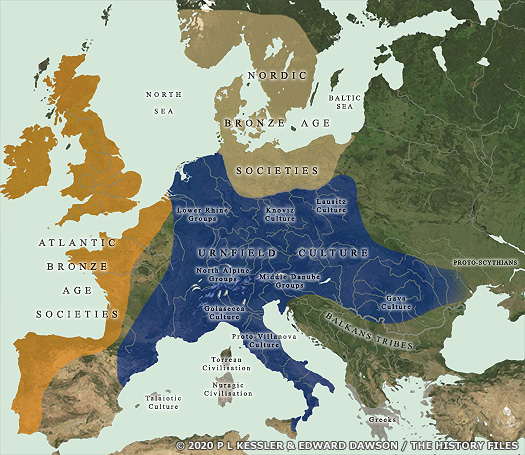 This map showing Late Bronze Age cultures in Europe displays the widespread expansion of the Urnfield culture and many of its splinter groups, although not the smaller groups who reached Britain, Iberia, and perhaps Scandinavia too (click or tap on map to view full sized) This map showing Late Bronze Age cultures in Europe displays the widespread expansion of the Urnfield culture and many of its splinter groups, although not the smaller groups who reached Britain, Iberia, and perhaps Scandinavia too (click or tap on map to view full sized) |
This is also the period in which the Iron Age begins to arrive in Britain, introduced alongside proto-Celtic settlers. The site of Caerau in the later territory of the Silures shows evidence of this, although the initial spread of the Celtic newcomers is probably confined to the south and south-east coast before it moves inland. It is quite possible that with most of southern Britain eventually dominated by Celts, the pre-Indo-European natives of the west and north respond to the threat by building defences which contain the latest technological advances, typical of those seen at Caerau. The use of iron weapons would more quickly supplant bronze ones as a matter of necessity, and pockets of pre-Indo-Europeans would survive and persist much as later Romano-Britons do in the face of Anglo-Saxon advances, with the natives adopting elements of the newcomers' weapons and fighting techniques as a matter of survival. Either way, Celtic language and the tough iron swords of the Celts gradually replace native language and soft bronze swords across the country over the course of the next two and-a-half centuries. 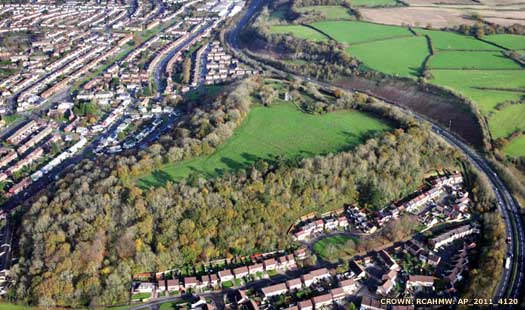 The Welsh hill fort of Caerau (pronounced Caer-eye) now stands on the edge of a modern housing estate on Cardiff's outskirts and with a road cutting through part of the lower hill The Welsh hill fort of Caerau (pronounced Caer-eye) now stands on the edge of a modern housing estate on Cardiff's outskirts and with a road cutting through part of the lower hill |
|
| c.730s - 720s BC |
 It seems to be around this time that the window for the 'Thraco-Cimmerian Hypothesis' first opens (see feature link). The Cimmerians and Scythians have suddenly positioned themselves as a more powerful collection of tribes which are not afraid of thundering around the Black Sea coast (on either side of the sea itself) and waging war against established kingdoms. It is known that Cimmerians later settle amongst the Thracian tribes. In order to be so welcomed they must share some common points of interest, such as language or culture. The common points would seem to be old Urnfield traditions in metalwork, mixed with new Cimmerian influences from the Caucasus. Could they already be mixing with Thracians now, with some groups beginning to explore farther along the River Danube to enter regions which are controlled by Celts of the Hallstatt C culture? The weight of evidence shows that there is indeed a warrior culture of the horse/wagon complex in the eighth century BC and also a shift in production centres from Hungary to Italy and the Alpine region. This would match well with a Thraco-Cimmerian migration along the Danube (whether in person or by osmosis through neighbouring migratory groups). It seems to be around this time that the window for the 'Thraco-Cimmerian Hypothesis' first opens (see feature link). The Cimmerians and Scythians have suddenly positioned themselves as a more powerful collection of tribes which are not afraid of thundering around the Black Sea coast (on either side of the sea itself) and waging war against established kingdoms. It is known that Cimmerians later settle amongst the Thracian tribes. In order to be so welcomed they must share some common points of interest, such as language or culture. The common points would seem to be old Urnfield traditions in metalwork, mixed with new Cimmerian influences from the Caucasus. Could they already be mixing with Thracians now, with some groups beginning to explore farther along the River Danube to enter regions which are controlled by Celts of the Hallstatt C culture? The weight of evidence shows that there is indeed a warrior culture of the horse/wagon complex in the eighth century BC and also a shift in production centres from Hungary to Italy and the Alpine region. This would match well with a Thraco-Cimmerian migration along the Danube (whether in person or by osmosis through neighbouring migratory groups). 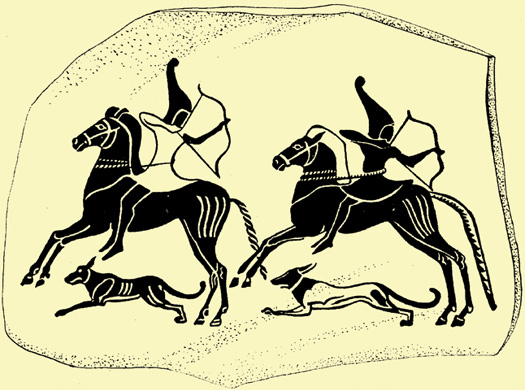 The year 652 BC marked the apogee of Cimmerian power, with their conquest of the kingdom of Lydia, but their supremacy would last only another eleven or so years before defeat and total eclipse The year 652 BC marked the apogee of Cimmerian power, with their conquest of the kingdom of Lydia, but their supremacy would last only another eleven or so years before defeat and total eclipse |
| In successive waves from the ninth to the sixth centuries BC these migrating warrior groups push west towards the headwaters of the Danube before veering off to the north. Ultimately, one branch follows the course of the River Elbe. A second backtracks west from the headwaters of the Rhine, heading north-east to the Elbe and then north into Jutland (where it theoretically forms, or merges with the ancestors of, the Cimbri). |
|
| c.700 BC |
At the end of the Atlantic Bronze Age the second 'wave' of Celtic migration begins into Iberia. This is confusingly named, as it consists of 'first wave' Celts but also takes into account the proto-Celtic Urnfield migrations of around the beginning of the millennium. The dating is relatively close in time to Celtic migrations into Italy, around a century or more later. Overpopulation in southern Germany must be pretty bad at this time. Some elements of the Celtic populations in Iberia later migrate into Ireland, where in part, at least, they form a population known to the natives as the Erainn. Not so much a sudden influx of Celts, the migration into Iberia is more a general progression of Hallstatt culture tribes arriving at the Pyrenees and forcing their way across. These Hallstatt Celts remain largely undisturbed by the later La Tène culture Celts until Iberia is conquered by Rome. 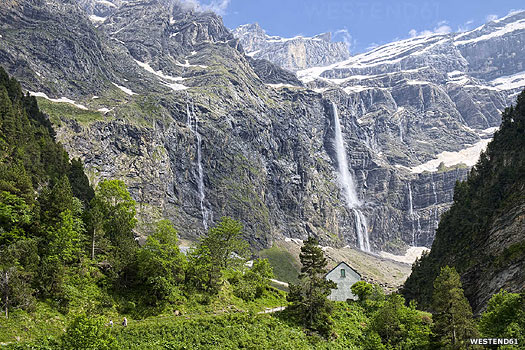 The Pyrenees (as seen here from the national park on the French side of the border) has presented a considerable obstacle to many migrating groups and campaigning armies, but there are paths across it, as the proto-Celtic Urnfield people and their Hallstatt culture successors found The Pyrenees (as seen here from the national park on the French side of the border) has presented a considerable obstacle to many migrating groups and campaigning armies, but there are paths across it, as the proto-Celtic Urnfield people and their Hallstatt culture successors found |
| It is this wave of Celts which ventures west through the Pyrenees to occupy the northern coast of the peninsula, and south beyond the Ebro and Duero basins as far as the Tagus valley. It is probably the strong presence of Iberians which prevents them from expanding farther. The Germanic peoples, still apparently occupying a possible original homeland in southern Sweden and the Jutland peninsula, appear to go through a period in which they are conquered by central Celts (Gauls) and remain subject to them (especially in Jutland). This leads to a good deal of cultural cross-contamination, with Germans exhibiting Celtic influences (in the form of words and names), and Celts exhibiting similar Germanic influences. This Northern European cross-cultural exchange is especially noticeable in many Belgic tribes of the first century BC, raising the possibility that they are the ones who initially dominate the Germanics at this time rather than the core Hallstatt Gauls themselves. |
|
| c.650 BC |
The Cadurci are thought to migrate across the Rhine, leaving the Celtic heartland in southern Germany to enter the land which becomes known as Gaul. The Lexovii make the same journey. 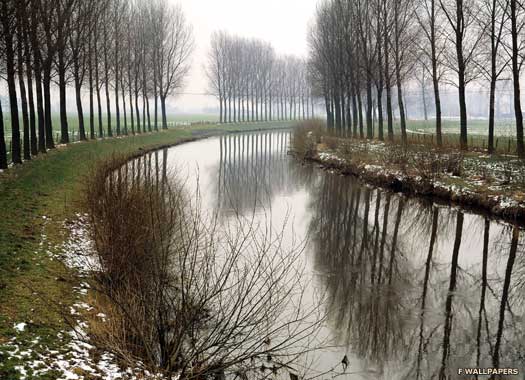 The Lower Rhine shown here was a mighty, if crossable, barrier but the Cadurci crossed much farther upriver, in the middle of the seventh century BC The Lower Rhine shown here was a mighty, if crossable, barrier but the Cadurci crossed much farther upriver, in the middle of the seventh century BC |
| Other Celtic groups are also settling in the British Isles and Ireland around this time. Whether the Cadurci tribe itself exists at this stage is entirely unknown. More probably, the migrants are one or more larger tribes which later divide and settle Gaul. It could take a further two or three centuries for the Cadurci to find a permanent home near the Garonne and evolve the identity which is later recorded by Caesar. Farther east, on the Black Sea coast, the name Tugdamme, a leader of Cimmerians at this time, is distinctly Celtic, with an automatic reconfiguration to the Celtic 'Togodumnos' being an easy leap. Given the possibility that it may be Thraco-Cimmerians who influence the Celtic progression from Hallstatt to La Tène culture during the proposed migration west from the Black Sea, Tugdamme could be a name type which is adopted by the Celts from the Cimmerian warrior elite and is afterwards rendered as Togodumnos (or variants). |
|
| 618 BC |
A huge early Celtic calendar construction is discovered in 2011 at the royal tomb of Magdalenenberg, near Villingen-Schwenningen in modern Germany's Black Forest. The order of the burials around the central royal tomb fits exactly with the constellations of the northern hemisphere. 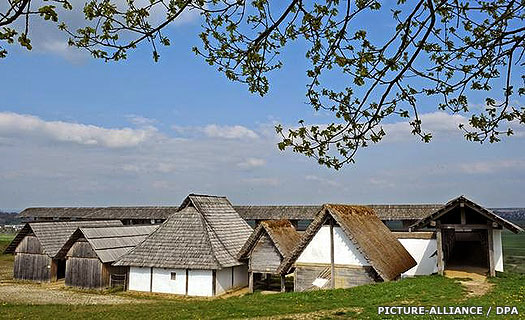 The Magdalenenberg site was hiding just a short distance from Heuneburg, a settlement in southern Germany which used to be held by a Celtic prince The Magdalenenberg site was hiding just a short distance from Heuneburg, a settlement in southern Germany which used to be held by a Celtic prince |
| Whereas Stonehenge in Britain is orientated towards the sun, the burial mound at Magdalenenberg, which is over a hundred metres wide, is focused towards the moon. The builders position long rows of wooden posts in the mound to be able to focus on the lunar standstills, which occur every eighteen-point-six years and are the cornerstones of the Celtic calendar. The position of the burials at Magdalenenberg represents a constellation pattern which can be seen between midwinter and midsummer. The positions of the constellations are recalculated back to this period by computer, resulting in a date of midsummer 618 BC, which makes it the earliest and most complete example of a Celtic calendar which is focused on the moon. |
|
| c.600 BC |
The first century BC writer, Livy (Titus Livius Patavinus), writes of an invasion into Italy of Celts during the reign of Lucius Tarquinius Priscus, king of Rome. As archaeology seems to point to a start date of around 500 BC for the beginning of a serious wave of Celtic incursions into Italy, this event has either been misremembered by later Romans or is an early precursor to the main wave of incursions. This outwards push is probably a result of the same apparent overpopulation in southern Germany which seems likely to be behind the start of migration into Iberia around a century earlier. This time, the Celtic advance into the Po Valley also forces the Raeti to relocate into the Alps (according to Pliny the Elder). 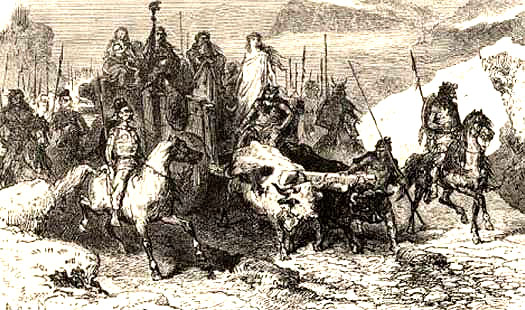 An idealised illustration of Gauls on an expedition, from A Popular History of France From The Earliest Times Volume I by Francois Pierre Guillaume Guizot An idealised illustration of Gauls on an expedition, from A Popular History of France From The Earliest Times Volume I by Francois Pierre Guillaume Guizot |
Could it also be linked to the influx of Thraco-Cimmerian migrants along the Danube who for some time seem to have been introducing gradual changes into Celtic society? The influx has seen the gradual replacement of a chariot-borne warrior culture with a lightly armed horse-borne one which is more able to attack larger and more powerful foes. Livy writes that two centuries before major Celtic attacks take place against Etruscans and Romans in Italy, a first wave of invaders from Gaul fights many battles against the Etruscans who dwell between the Apennines and the Alp. At this time, the Bituriges are the supreme power amongst the Celts (who already occupy a third of the whole of Gaul). They would be a prime example of the new-found dominance of the Hallstatt D tribes of southern Germany, Switzerland, and eastern France, replacing the wealthy Hallstatt C peoples as top dogs. Livy understands that this particular tribe had formerly supplied the king for the whole Celtic race, either suggesting a previously more central governance of the Celts which is now beginning to fragment or the typical assumption that one powerful king rules an entire people. The prosperous and courageous, but now-elderly Ambigatus is the ruler of the Bituriges, and over-population means a division of its number is required. Ambigatus sends his sister's sons, Bellovesus and Segovesus, to settle new lands with enough men behind them to put down any opposition. 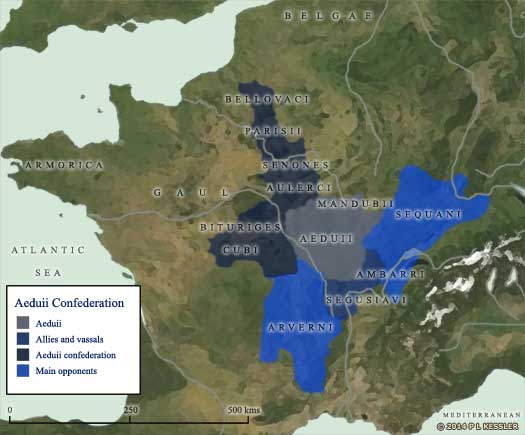 By about 100 BC the Bituriges were much reduced in stature, being a non-dominant part of the Aeduii confederation, with borders approximate and fairly conjectural (click or tap on map to view full sized) By about 100 BC the Bituriges were much reduced in stature, being a non-dominant part of the Aeduii confederation, with borders approximate and fairly conjectural (click or tap on map to view full sized) |
|
Following divination by the druids, Segovesus heads into the Hercynian Forest, on the east bank of the Rhine (this forms the northern border of the lands known to the ancient writers of the Mediterranean, and the modern Black Forest forms its western part). He ends up leading his groups into Carinthia (now in southern Austria) to found the Ambisontes and Ambidravi tribes (and possibly also the Ambilici). Bellovesus heads towards Italy, inviting fellow settlers to join him from six tribes, the Aeduii, Ambarri, Aulerci, Arverni, Bituriges, Carnutes, and Senones. The body of people who are led by Bellovesus himself apparently consists mainly of Insubres, a canton (or sub-division) of the Aeduii. Farther north, the Harii probably belong to the Hallstatt culture, along with the Abrincatui, Bebryces, Boii, Cotini, Helisii, Helveconae, Manimi, Naharvali, Osi, and at least some elements of the later Lugii. They are to be found around today's central Germany, and in Bohemia and Moravia, today's Slovakia, and the edges of modern Poland and Ukraine. To their north are what can be termed 'Northern Celts' - the proto-Belgae. The Bebryces are another migratory tribe at this time. They are primarily cattle herders so they take their herds with them, greatly supplementing their diet with milk, fatty cheese, and beef. Many others remain behind, in control of the region until pressure from newly-arriving Germanic tribes begins to erode their hold in the second and first centuries BC. 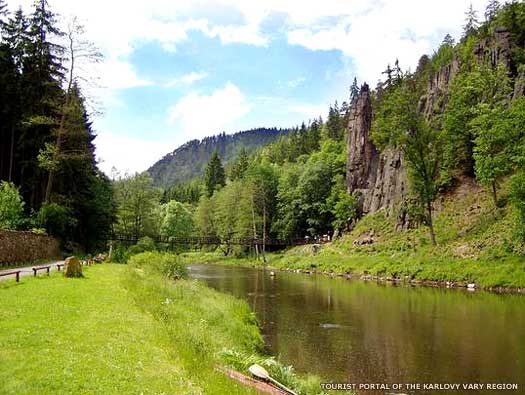 The landscape of Bohemia is and was defined by wooded mountainsides and extensive farming land - a green and fertile area at the centre of Europe and of the Hallstatt culture The landscape of Bohemia is and was defined by wooded mountainsides and extensive farming land - a green and fertile area at the centre of Europe and of the Hallstatt culture |
|
| 583 BC |
A 2010 archaeological discovery which is made in the upper reaches of the Danube (core Hallstatt territory) reveals the undisturbed burial of an aristocratic Celtic lady, the so-called 'Celtic princess'. The burial can be dated quite accurately thanks to the preservation in a wet environment of oak flooring in the large grave. The woman, presumed to be a member of the Celtic nobility, is laid to rest with large amounts of richly decorated gold and amber jewellery. She is aged between thirty and forty years old and has remarkably good teeth. The torso of her skeleton is found still complete, but the head is located three metres away and her lower jaw is in another corner of the burial site. The meaning behind this remains unclear. A child's body is present with her, probably one of her own children, along with another body which may be that of a servant. The find indicates that the Celts have an aristocratic hierarchy by this period, something which has previously been disputed by archaeologists (peculiarly, given that Indo-Europeans of the Yamnaya Horizon some two-or-more thousand years earlier clearly had a warrior class in command). 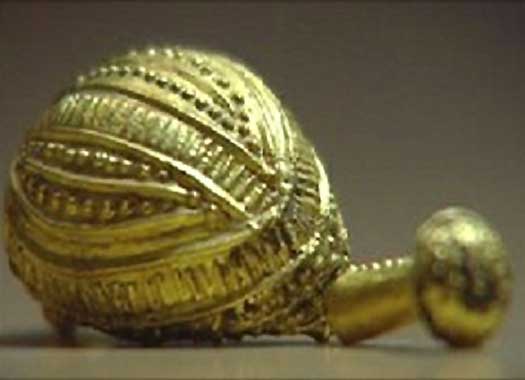 The gold and amber jewellery unearthed from the burial of the 'Celtic princess' show that very high levels of skill were involved in their creation in the first millennium BC The gold and amber jewellery unearthed from the burial of the 'Celtic princess' show that very high levels of skill were involved in their creation in the first millennium BC |
| The burial objects also reveal some details of Celtic society which have been unknown until now. An ornamental armour for horses is found next to the unidentified woman, but this is not typical of the region. This object may come from northern Italy, whereas other elements come from the south. Celts are therefore involved in more interregional trade than archaeologists have previously thought (or they have seized these items during their recent ingress into northern Italy). It is the oldest princely female grave of the Celtic world to be discovered to date, and the only example of an early Celtic princely grave with a wooden chamber. Initially dated to 609 BC, the burial has been recalculated at 583 BC thanks to the very precise dating of the wood, which was taken from a fir tree. |
|
| c.580 BC |
The major Etruscan centres of Padan Etruria are being founded at this time. This region to the north-east of the Etruscan heartland in Italy is settled up to three hundred years later than the main Etruscan centres, and has a long tradition of interaction with the Celtic tribes to the north which remains largely peaceful until the late fourth century. Epigraphic inscriptions testify to the cohabitation and intermarriage of Celts and Etruscans. 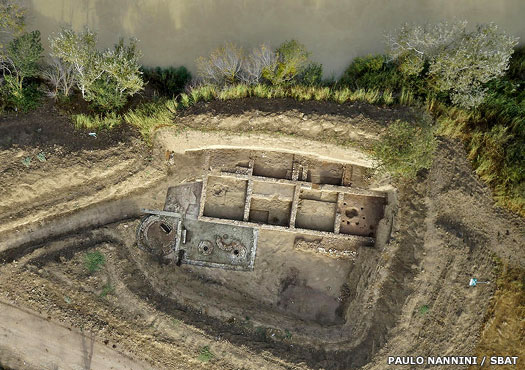 The Etruscan city of Rusellae quickly developed as an important river port facility on the River Ombrone, and it remained important well into the Roman domination of Italy until it began to fade in the sixth century AD The Etruscan city of Rusellae quickly developed as an important river port facility on the River Ombrone, and it remained important well into the Roman domination of Italy until it began to fade in the sixth century AD |
| c.500 BC |
Evidence of the spread of Celtic customs and artefacts can be found in Britain for this period. More and varied types of pottery are in use, and there is more characteristic decoration of jewellery. There is no known 'invasion' of Britain by Celts as their arrival is likely to be a more gradual infiltration into existing British society through trade and other contacts over a period of several hundred years, building up settlements along the coastline and later migrating inwards. More Celtic settlement can soon be found in Ireland. To support this view of Celtic integration into Britain, it appears that the R-U152 can largely be traced to various movements of people from what are today France and Belgium and whose origins are rooted in the Iron Age La Tène Celtic peoples who are now becoming evident to the west of the Rhine. Some of these peoples are likely to remain around their heartland of the Seine and Marne and Mosel areas, but between about 500 to 400 BC these areas see a dramatic decrease in population when large numbers migrate to the east, to locations in Pomeranian culture Poland, modern Czechia, Slovakia, Hungary, and the Balkans, and east to Ukraine. This would seem to be a continuation and enhancement of earlier Hallstatt migrations into these regions a century or so beforehand. 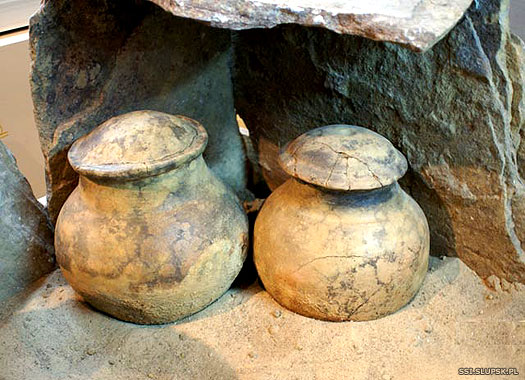 A Pomeranian/Face-Urn culture tomb chest constructed at a time of greater metallurgy skills but with weaker ceramic skills when compared to the preceding Lusatian culture A Pomeranian/Face-Urn culture tomb chest constructed at a time of greater metallurgy skills but with weaker ceramic skills when compared to the preceding Lusatian culture |
| c.500 - 335 BC |
The Chiemgau impact (or hypothesis) is a controversial assertion which involves Central Europe being struck by a meteorite, with the dates used here being the most likely period for that impact. There seems to be a core resistance to its acceptance which dismisses it as 'an obsolete scientific theory', but the evidence to back it up is growing and is rather convincing to an open mind. The location is in Upper Bavaria, part of the heartland of Celtic territory at this time (but also incorporating Vindelici territory), with Lake Chiemsee at its centre. The hypothesis asserts that a large cosmic body (a comet or an asteroid) strikes the ground and leaves a large crater-strewn field with all the relevant impact evidence which such a strike entails. A strike like this must have a severe effect on the tribes in the region. Much like the Tunguska strike of 1905 and the Tschebarkul 2013 super bolide of Tscheljabinsk in Russia which has been seen far and wide even without the aid of modern communications technology, this strike will be witnessed by a great many people. The means of narrowing the impact date to around 500-335 BC is highly detailed (see the link in the sources, above), but this would certainly serve to provide a reason for the Celts (Gauls) being quoted as fearing nothing but the sky falling on their heads (the Asterix strips make especial use of this). 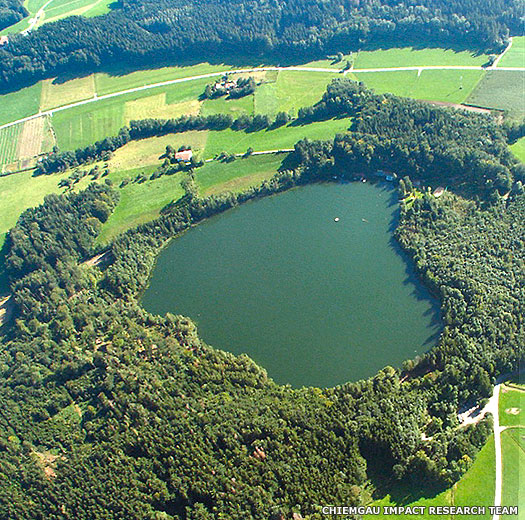 The largest crater in the Chiemgau field in Bavaria is the water-filled T�ttensee which is located near the village of Marwang The largest crater in the Chiemgau field in Bavaria is the water-filled T�ttensee which is located near the village of Marwang |
| 5th century BC |
The Brigantii migrate into the Cispadane Gaul region of the Alps, arriving in an area which has already been settled for a millennium. Strabo later states that they are a sub-tribe of the Vindelici, who occupy territory to the north-east. This could indicate the route taken by the Brigantii to reach their new home, but it also raises the possibility that they are not Gauls, or perhaps only partially so. The Vindelici have an uncertain ancestry, possibly being a blend of Celts and Ligurians (such as the Celto-Ligurian Orobii), making it equally possible that the Brigantii are Ligurians who are commanded by a Gaulish elite. Even referring to the Brigantii as Celts is merely the modern naming convention which has been inherited from the Romans. Thinking of the term as valid or invalid may be irrelevant. 'Celt' may simply be what some West Indo-European speakers call themselves and others not - and with the Celts long in the ascendance in Central Europe, some non-Celtic people may arbitrarily adopt the term in order to fit in. The arrival of the Brigantii probably causes some disturbance amongst the established native tribes, and very likely some fighting. The Brigantii soon establish a settlement called Brigantion (according to Strabo), which becomes one of their most heavily-fortified locations. No doubt the indigenous tribes still pose a threat. 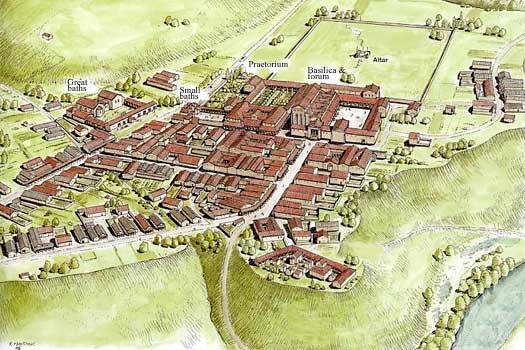 The Brigantii settlement of Cambodunum, which was located in what is now south-western Bavaria, which was part of the heartland of early Celtic development and culture The Brigantii settlement of Cambodunum, which was located in what is now south-western Bavaria, which was part of the heartland of early Celtic development and culture |
Also dated to the fifth century BC is a Celtic warrior burial which is unearthed by archaeologists in 2014 (discovered in a business zone on the outskirts of Lavau in modern France's Champagne region, close to Troyes). The 'exceptional' grave of this prince is crammed with Greek and, possibly, Etruscan artefacts. The prince is buried with his chariot in a fourteen square-metre-large burial chamber, at the heart of a huge mound which itself measures forty metres across, although at this point the mound is yet to be opened. The biggest initial find at the site is a huge wine cauldron. Standing on the handles of the cauldron is the Greek god Acheloos. This river deity is shown with horns, a beard, the ears of a bull, and a triple moustache. Eight lioness heads decorate the cauldron's edge. Inside it, archaeologists discover a ceramic wine vessel, called an oniochoe. Other interesting discoveries include a perforated silver spoon which had been part of a set of banqueting utensils, and presumably had been used to filter the wine, and the remains of an iron wheel from the chariot which had been buried with the prince. 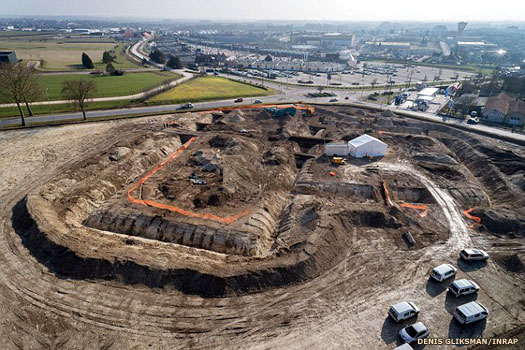 An Iron Age Celtic prince lay buried with his chariot at the centre of this huge mound in the Champagne region of France, according to the country's National Archaeological Research Institute An Iron Age Celtic prince lay buried with his chariot at the centre of this huge mound in the Champagne region of France, according to the country's National Archaeological Research Institute |
|
| Trying to pin down the prince's tribe would be highly speculative given that he has been laid to rest around four hundred and fifty years before Julius Caesar records the names of Gaul's tribes in detail. By the first century BC the Champagne region near Troyes is principally occupied by the Tricasses, who have Augusta Tricassium (Troyes) as their oppidum. Nearby tribes include the Catuvellauni and Mandubii, while the larger Lingones lie to the south-east and the mighty Aeduii to the south. The prince would no doubt belong to a larger collective which has since divided (probably several times) to produce the plethora of first century tribes. Overall, like a stone dropped into a pool of water, the Hallstatt Celts have rippled outwards, vastly increasing the territory which is under their influence or control. By the middle of the fifth century BC that effect has faded and a new ripple effect is taking its place. |
|
| 5th century BC |
Hallstatt migrations continue to take place farther out from the heartland (such as into the Balkans in the third century BC), but it is now their successors, the La Tène Celts, who expand out from Central Europe along the same expansion paths over the next four-or-so centuries. |
 |
|
 The system which has evolved to catalogue the various archaeological expressions of human progress is one which involves cultures. For well over a century, archaeological cultures have remained the framework for global prehistory. The earliest cultures which emerge from Africa and the Near East are perhaps the easiest to catalogue, right up until human expansion reaches the Americas. The task of cataloguing that vast range of human cultures is covered in the related feature (see feature link, right).
The system which has evolved to catalogue the various archaeological expressions of human progress is one which involves cultures. For well over a century, archaeological cultures have remained the framework for global prehistory. The earliest cultures which emerge from Africa and the Near East are perhaps the easiest to catalogue, right up until human expansion reaches the Americas. The task of cataloguing that vast range of human cultures is covered in the related feature (see feature link, right).  It seems highly likely from detailed analysis that the first wave of Indo-European-speaking peoples to arrive in Western Europe were members of the West Indo-European proto-Italic branch. They displaced - and more often incorporated - early inhabitants who appear physically to have been Mediterranean prehistoric folk who spoke non-Indo-European languages from the Dene-Caucasian language group (see index link for a list of early cultures). Historically, records exist of these indigenous peoples where they were mentioned by Greek and Roman sources. The ancient Greeks called the indigenous people in their area Pelasgians. The Romans knew theirs as Etruscans, and indeed received much of their early civilising influences from them. The Romans also encountered them in the form of the Aquitani, whom are known today as Basques. In the British Isles there is speculation that some of the Picts may have hailed from this group of prehistoric folk. Physically these early peoples appear to have been of middle height, slender, and with black hair and dark brown eyes. These characteristics are widely seen across Europe (in France, Italy, Portugal, and Wales, and elsewhere too), providing a clear indication of ancestry. There appears to have been another human type, possibly predating the Mediterraneans, which older anthropologists called Alpines. Their range is mixed amongst Mediterraneans, but in many places they were found along the western 'fringe' of Europe or, as in the case of the Alpines proper, in mountain areas. In modern Britain and Ireland this type is found scattered through much of the fringes, and appears often in the mountain areas, especially in mid-Wales. This type is usually of a stocky build, and with a rounded head shape. Colouration varies, which would be in line with an older stock much admixed with two major waves of invaders (Mediterraneans and Indo-Europeans) and long adapted to their environs. Into this mix was added the proto-Celtic Urnfield culture which greatly expanded Indo-European influence across many regions of Europe which previously had been populated entirely by indigenous groups. In the very heartland of Urnfield culture, between Switzerland and Bavaria, a new culture emerged around 800 BC called the Hallstatt. This was the first true Celtic culture, one which was a direct continuation of the Urnfield culture, and its export outwards into western, southern, and Eastern Europe became the 'first wave' of true Celtic expansion (notwithstanding the wave of Urnfield-related population expansion which had already been experienced). More controversially, there may also have been Celtic expansion into Northern Europe. If the Urnfield culture had not already generated mixed Celto-Germanic groups itself, then this expansion can be claimed to have done so in its place, with this probable mixture rightly being claimed as the origin of the Belgic group of Celts. The same uncertainty exists in relation to the formation of the 'Eastern Celts' - the Venedi.
It seems highly likely from detailed analysis that the first wave of Indo-European-speaking peoples to arrive in Western Europe were members of the West Indo-European proto-Italic branch. They displaced - and more often incorporated - early inhabitants who appear physically to have been Mediterranean prehistoric folk who spoke non-Indo-European languages from the Dene-Caucasian language group (see index link for a list of early cultures). Historically, records exist of these indigenous peoples where they were mentioned by Greek and Roman sources. The ancient Greeks called the indigenous people in their area Pelasgians. The Romans knew theirs as Etruscans, and indeed received much of their early civilising influences from them. The Romans also encountered them in the form of the Aquitani, whom are known today as Basques. In the British Isles there is speculation that some of the Picts may have hailed from this group of prehistoric folk. Physically these early peoples appear to have been of middle height, slender, and with black hair and dark brown eyes. These characteristics are widely seen across Europe (in France, Italy, Portugal, and Wales, and elsewhere too), providing a clear indication of ancestry. There appears to have been another human type, possibly predating the Mediterraneans, which older anthropologists called Alpines. Their range is mixed amongst Mediterraneans, but in many places they were found along the western 'fringe' of Europe or, as in the case of the Alpines proper, in mountain areas. In modern Britain and Ireland this type is found scattered through much of the fringes, and appears often in the mountain areas, especially in mid-Wales. This type is usually of a stocky build, and with a rounded head shape. Colouration varies, which would be in line with an older stock much admixed with two major waves of invaders (Mediterraneans and Indo-Europeans) and long adapted to their environs. Into this mix was added the proto-Celtic Urnfield culture which greatly expanded Indo-European influence across many regions of Europe which previously had been populated entirely by indigenous groups. In the very heartland of Urnfield culture, between Switzerland and Bavaria, a new culture emerged around 800 BC called the Hallstatt. This was the first true Celtic culture, one which was a direct continuation of the Urnfield culture, and its export outwards into western, southern, and Eastern Europe became the 'first wave' of true Celtic expansion (notwithstanding the wave of Urnfield-related population expansion which had already been experienced). More controversially, there may also have been Celtic expansion into Northern Europe. If the Urnfield culture had not already generated mixed Celto-Germanic groups itself, then this expansion can be claimed to have done so in its place, with this probable mixture rightly being claimed as the origin of the Belgic group of Celts. The same uncertainty exists in relation to the formation of the 'Eastern Celts' - the Venedi.  The opinion has been expressed by some authors that, in the eighth century BC, a 'Thraco-Cimmerian' migration triggered cultural changes which contributed to the transformation of the Urnfield culture into the Hallstatt C culture, and thereby ushered in the European Iron Age. This theory is still highly controversial though, and is discussed in detail via the feature link, right. The warrior culture of the Celts was actually the standard Indo-European warrior culture, but perhaps regional elements existed which were added to the Urnfield culture at just the right time. As mentioned in the introduction for the Celts (see that page), the once-universal Indo-European language and culture quickly broke down into many regional variations, two being Iberian Q-Celtic, and Italian Q-Italic. These were quite similar, with both cultures preferring the short stabbing sword, and speaking closely related languages. The first wave of Celts themselves were also Q-Celtic speakers, seemingly being most closely related to the Italic tribes such as the Latins.
The opinion has been expressed by some authors that, in the eighth century BC, a 'Thraco-Cimmerian' migration triggered cultural changes which contributed to the transformation of the Urnfield culture into the Hallstatt C culture, and thereby ushered in the European Iron Age. This theory is still highly controversial though, and is discussed in detail via the feature link, right. The warrior culture of the Celts was actually the standard Indo-European warrior culture, but perhaps regional elements existed which were added to the Urnfield culture at just the right time. As mentioned in the introduction for the Celts (see that page), the once-universal Indo-European language and culture quickly broke down into many regional variations, two being Iberian Q-Celtic, and Italian Q-Italic. These were quite similar, with both cultures preferring the short stabbing sword, and speaking closely related languages. The first wave of Celts themselves were also Q-Celtic speakers, seemingly being most closely related to the Italic tribes such as the Latins.  Archaeological finds are constantly being made, and archaeological cultures are frequently being updated with new information. Get in touch here if this page also requires updating.
Archaeological finds are constantly being made, and archaeological cultures are frequently being updated with new information. Get in touch here if this page also requires updating.
 This map showing Late Bronze Age cultures in Europe displays the widespread expansion of the Urnfield culture and many of its splinter groups, although not the smaller groups who reached Britain, Iberia, and perhaps Scandinavia too (click or tap on map to view full sized)
This map showing Late Bronze Age cultures in Europe displays the widespread expansion of the Urnfield culture and many of its splinter groups, although not the smaller groups who reached Britain, Iberia, and perhaps Scandinavia too (click or tap on map to view full sized) The Welsh hill fort of Caerau (pronounced Caer-eye) now stands on the edge of a modern housing estate on Cardiff's outskirts and with a road cutting through part of the lower hill
The Welsh hill fort of Caerau (pronounced Caer-eye) now stands on the edge of a modern housing estate on Cardiff's outskirts and with a road cutting through part of the lower hill It seems to be around this time that the window for the 'Thraco-Cimmerian Hypothesis' first opens (see feature link). The Cimmerians and Scythians have suddenly positioned themselves as a more powerful collection of tribes which are not afraid of thundering around the Black Sea coast (on either side of the sea itself) and waging war against established kingdoms. It is known that Cimmerians later settle amongst the Thracian tribes. In order to be so welcomed they must share some common points of interest, such as language or culture. The common points would seem to be old Urnfield traditions in metalwork, mixed with new Cimmerian influences from the Caucasus. Could they already be mixing with Thracians now, with some groups beginning to explore farther along the River Danube to enter regions which are controlled by Celts of the Hallstatt C culture? The weight of evidence shows that there is indeed a warrior culture of the horse/wagon complex in the eighth century BC and also a shift in production centres from Hungary to Italy and the Alpine region. This would match well with a Thraco-Cimmerian migration along the Danube (whether in person or by osmosis through neighbouring migratory groups).
It seems to be around this time that the window for the 'Thraco-Cimmerian Hypothesis' first opens (see feature link). The Cimmerians and Scythians have suddenly positioned themselves as a more powerful collection of tribes which are not afraid of thundering around the Black Sea coast (on either side of the sea itself) and waging war against established kingdoms. It is known that Cimmerians later settle amongst the Thracian tribes. In order to be so welcomed they must share some common points of interest, such as language or culture. The common points would seem to be old Urnfield traditions in metalwork, mixed with new Cimmerian influences from the Caucasus. Could they already be mixing with Thracians now, with some groups beginning to explore farther along the River Danube to enter regions which are controlled by Celts of the Hallstatt C culture? The weight of evidence shows that there is indeed a warrior culture of the horse/wagon complex in the eighth century BC and also a shift in production centres from Hungary to Italy and the Alpine region. This would match well with a Thraco-Cimmerian migration along the Danube (whether in person or by osmosis through neighbouring migratory groups).  The year 652 BC marked the apogee of Cimmerian power, with their conquest of the kingdom of Lydia, but their supremacy would last only another eleven or so years before defeat and total eclipse
The year 652 BC marked the apogee of Cimmerian power, with their conquest of the kingdom of Lydia, but their supremacy would last only another eleven or so years before defeat and total eclipse The Pyrenees (as seen here from the national park on the French side of the border) has presented a considerable obstacle to many migrating groups and campaigning armies, but there are paths across it, as the proto-Celtic Urnfield people and their Hallstatt culture successors found
The Pyrenees (as seen here from the national park on the French side of the border) has presented a considerable obstacle to many migrating groups and campaigning armies, but there are paths across it, as the proto-Celtic Urnfield people and their Hallstatt culture successors found The Lower Rhine shown here was a mighty, if crossable, barrier but the Cadurci crossed much farther upriver, in the middle of the seventh century BC
The Lower Rhine shown here was a mighty, if crossable, barrier but the Cadurci crossed much farther upriver, in the middle of the seventh century BC The Magdalenenberg site was hiding just a short distance from Heuneburg, a settlement in southern Germany which used to be held by a Celtic prince
The Magdalenenberg site was hiding just a short distance from Heuneburg, a settlement in southern Germany which used to be held by a Celtic prince An idealised illustration of Gauls on an expedition, from A Popular History of France From The Earliest Times Volume I by Francois Pierre Guillaume Guizot
An idealised illustration of Gauls on an expedition, from A Popular History of France From The Earliest Times Volume I by Francois Pierre Guillaume Guizot By about 100 BC the Bituriges were much reduced in stature, being a non-dominant part of the Aeduii confederation, with borders approximate and fairly conjectural (click or tap on map to view full sized)
By about 100 BC the Bituriges were much reduced in stature, being a non-dominant part of the Aeduii confederation, with borders approximate and fairly conjectural (click or tap on map to view full sized) The landscape of Bohemia is and was defined by wooded mountainsides and extensive farming land - a green and fertile area at the centre of Europe and of the Hallstatt culture
The landscape of Bohemia is and was defined by wooded mountainsides and extensive farming land - a green and fertile area at the centre of Europe and of the Hallstatt culture The gold and amber jewellery unearthed from the burial of the 'Celtic princess' show that very high levels of skill were involved in their creation in the first millennium BC
The gold and amber jewellery unearthed from the burial of the 'Celtic princess' show that very high levels of skill were involved in their creation in the first millennium BC The Etruscan city of Rusellae quickly developed as an important river port facility on the River Ombrone, and it remained important well into the Roman domination of Italy until it began to fade in the sixth century AD
The Etruscan city of Rusellae quickly developed as an important river port facility on the River Ombrone, and it remained important well into the Roman domination of Italy until it began to fade in the sixth century AD A Pomeranian/Face-Urn culture tomb chest constructed at a time of greater metallurgy skills but with weaker ceramic skills when compared to the preceding Lusatian culture
A Pomeranian/Face-Urn culture tomb chest constructed at a time of greater metallurgy skills but with weaker ceramic skills when compared to the preceding Lusatian culture The largest crater in the Chiemgau field in Bavaria is the water-filled T�ttensee which is located near the village of Marwang
The largest crater in the Chiemgau field in Bavaria is the water-filled T�ttensee which is located near the village of Marwang The Brigantii settlement of Cambodunum, which was located in what is now south-western Bavaria, which was part of the heartland of early Celtic development and culture
The Brigantii settlement of Cambodunum, which was located in what is now south-western Bavaria, which was part of the heartland of early Celtic development and culture An Iron Age Celtic prince lay buried with his chariot at the centre of this huge mound in the Champagne region of France, according to the country's National Archaeological Research Institute
An Iron Age Celtic prince lay buried with his chariot at the centre of this huge mound in the Champagne region of France, according to the country's National Archaeological Research Institute